android游戏开发框架libgdx的使用(十二)—TiledMap地图的使用
转载声明:http://www.cnblogs.com/htynkn/archive/2012/01/12/libgdx_12.html
虽说可以用Image什么的当个背景,但是要是做个RPG类的游戏就有点复杂了。为了追求效率一般可以使用libgdx的SpriteCache,但是如果习惯于TiledMap的话libgdx也是支持的。
相关的类是TiledMap,TileAtlas,TileMapRenderer,都在com.badlogic.gdx.graphics.g2d.tiled之中。
现在我们从头来看看TiledMap的使用。
1.制作TiledMap。
我使用的是Tile Map editor,下载地址:http://www.mapeditor.org/
先新建一个地图,大小50*30,每个块的大小是32*32。
然后我使用的图块资源是从网上下的,具体出处不知了,对于资源奉献者表示感谢~
添加一个新图块
块的高宽都是32.边距和间距都是1px,这些数值是取决你的图块资源本身的。效果如下:
然后发挥想象吧,画一幅地图。
保存tmx文件。然后用gdx-tiled-preprocessor处理一下。
处理完成后会多三个文件,覆盖原来的同名文件:
tilest1.png文件:
终于可以开始绘制了…
1 map = TiledLoader.createMap(mapHandle); 2 atlas = new TileAtlas(map, new FileHandle("map/")); 3 tileMapRenderer = new TileMapRenderer(map, atlas, 10, 10)
最后在render用tileMapRenderer.render(cam);绘制
而在TileMapRenderer(map, atlas, 10, 10)这句中后面两个10是缓冲的块数,可以酌情调整。我是随意写的。
我个人比较喜欢舞台,其实tiledmap一样可以在舞台中使用。
我在舞台绘制一个标签作为例子。
其实原理很简单,从Stage获取Camera,然后给Render用,最后在Stage绘制。
关键代码:
1 Gdx.gl.glClear(GL10.GL_COLOR_BUFFER_BIT); 2 OrthographicCamera c = (OrthographicCamera) stage.getCamera(); 3 ((Label) stage.findActor("fpsLabel")).setText("FPS: " 4 + Gdx.graphics.getFramesPerSecond()); 5 stage.act(Gdx.graphics.getDeltaTime()); 6 tileMapRenderer.render(c); 7 stage.draw();
完整代码:
1 package com.cnblogs.htynkn.game; 2 3 import com.badlogic.gdx.ApplicationListener; 4 import com.badlogic.gdx.Gdx; 5 import com.badlogic.gdx.files.FileHandle; 6 import com.badlogic.gdx.graphics.Color; 7 import com.badlogic.gdx.graphics.GL10; 8 import com.badlogic.gdx.graphics.OrthographicCamera; 9 import com.badlogic.gdx.graphics.g2d.BitmapFont; 10 import com.badlogic.gdx.graphics.g2d.tiled.TileAtlas; 11 import com.badlogic.gdx.graphics.g2d.tiled.TileMapRenderer; 12 import com.badlogic.gdx.graphics.g2d.tiled.TiledLoader; 13 import com.badlogic.gdx.graphics.g2d.tiled.TiledMap; 14 import com.badlogic.gdx.math.Vector2; 15 import com.badlogic.gdx.math.Vector3; 16 import com.badlogic.gdx.scenes.scene2d.Stage; 17 import com.badlogic.gdx.scenes.scene2d.ui.Image; 18 import com.badlogic.gdx.scenes.scene2d.ui.Label; 19 import com.badlogic.gdx.scenes.scene2d.ui.Label.LabelStyle; 20 21 public class JavaGame implements ApplicationListener { 22 23 Stage stage; 24 float width; 25 float height; 26 private TiledMap map; 27 private TileAtlas atlas; 28 private TileMapRenderer tileMapRenderer; 29 30 Vector3 camDirection = new Vector3(1, 1, 0); 31 Vector2 maxCamPosition = new Vector2(0, 0); 32 33 Image image; 34 35 @Override 36 public void create() { 37 final String path = "map/"; 38 final String mapname = "tilemap"; 39 FileHandle mapHandle = Gdx.files.internal(path + mapname + ".tmx"); 40 map = TiledLoader.createMap(mapHandle); 41 atlas = new TileAtlas(map, new FileHandle("map/")); 42 tileMapRenderer = new TileMapRenderer(map, atlas, 10, 10); 43 maxCamPosition.set(tileMapRenderer.getMapWidthUnits(), tileMapRenderer 44 .getMapHeightUnits()); 45 46 width = Gdx.graphics.getWidth(); 47 height = Gdx.graphics.getHeight(); 48 stage = new Stage(width, height, true); 49 Label label = new Label("FPS:", new LabelStyle(new BitmapFont(Gdx.files 50 .internal("font/blue.fnt"), 51 Gdx.files.internal("font/blue.png"), false), Color.BLACK), 52 "fpsLabel"); 53 stage.addActor(label); 54 Gdx.input.setInputProcessor(stage); 55 } 56 57 @Override 58 public void dispose() { 59 // TODO Auto-generated method stub 60 61 } 62 63 @Override 64 public void pause() { 65 // TODO Auto-generated method stub 66 67 } 68 69 @Override 70 public void render() { 71 Gdx.gl.glClear(GL10.GL_COLOR_BUFFER_BIT); 72 OrthographicCamera c = (OrthographicCamera) stage.getCamera(); 73 ((Label) stage.findActor("fpsLabel")).setText("FPS: " 74 + Gdx.graphics.getFramesPerSecond()); 75 stage.act(Gdx.graphics.getDeltaTime()); 76 tileMapRenderer.render(c); 77 stage.draw(); 78 } 79 80 @Override 81 public void resize(int width, int height) { 82 // TODO Auto-generated method stub 83 84 } 85 86 @Override 87 public void resume() { 88 // TODO Auto-generated method stub 89 90 } 91 }
效果不是很明显,左下角有个Label。
虽说我们绘制出来了Map,但是还没有角色,而且还没有设置墙壁等障碍,接下来的几篇文章会说说这些。
写在最后:
1.做好的TMX文件一定要处理以后再用,用TiledMapPacker处理,不是TexturePacker。我起初弄混淆了,结果把这一块的代码读懂了才反应过来…
2.Stage和TiledMap混用时,一定是stage的绘制在后。
3.Stage的相机可以移动,移动时会产生地图移动效果(比如主角向前走),但是一定要更新Stage的Actors的位置。
这篇博文写了一天半,主要是我粗心把TiledMapPacker和TexturePacker搞错,仔细看了看TexturePacker,觉得 TexturePacker也是很有用的东西。算法很有趣,而且还有热心网友做的一个GUI界面,用这个就不用自己辛苦拉图了。
算法介绍:http://www.blackpawn.com/texts/lightmaps/default.html
GUI界面的TexturePacker:http://code.google.com/p/libgdx-texturepacker-gui/
特别说明:
我操作的时候没有任何问题...要是各位遇到问题,请细心调试,可以参考一下:http://www.cnblogs.com/SkyD/archive/2012/04/19/2457237.html
这里还有博友破木吉他关于tilemap生成的文章:http://bluthmatter.blog.163.com/blog/static/18429405920124205458401/



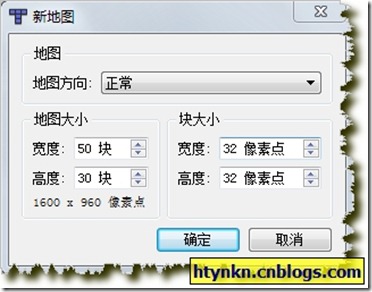

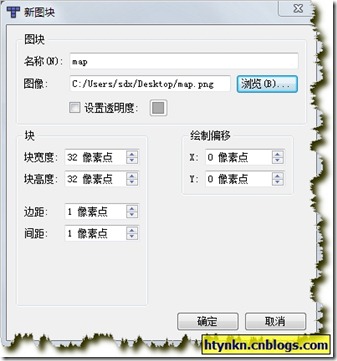
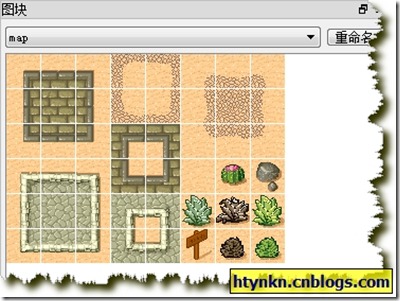
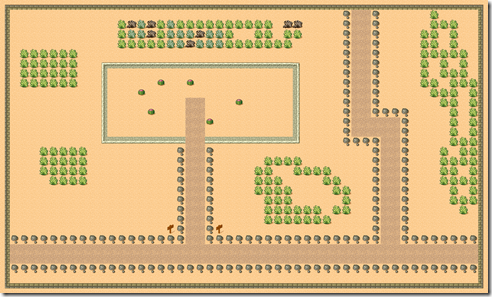



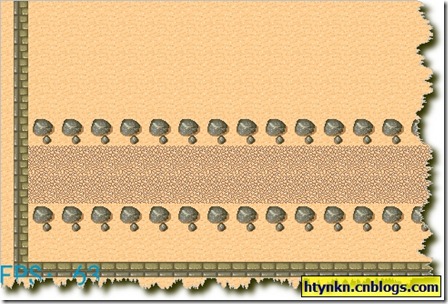

 浙公网安备 33010602011771号
浙公网安备 33010602011771号